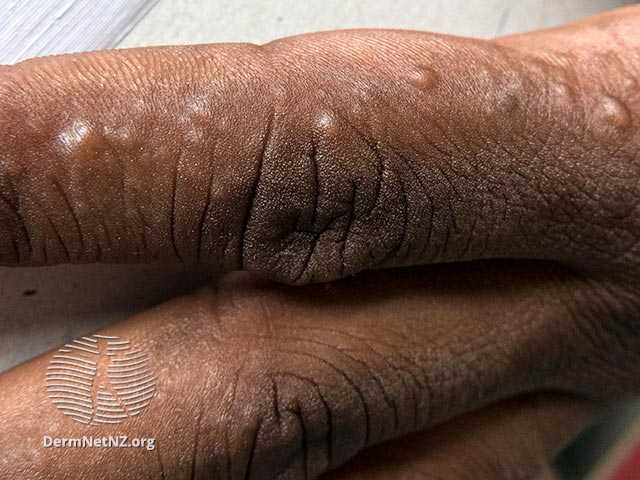

Do you recognize these exquisitely itchy little bumps? It’s time to demystify a troubling and sometimes mysterious rash called dyshidrotic eczema.
In dermatology residency, many of us learn the term “tapioca-like vesicles” (we love using food-related descriptors) to describe the characteristic appearance of a type of eczema called dyshidrotic eczema (AKA pompholyx and acute recurrent vesicular eczema).

Since October is Eczema Awareness Month, let’s dive in.
The bumps are usually filled with clear fluid but can sometimes look red or white. They start out as 1-2 mm ITCHY (a hallmark of eczema) bumps, typically on the hands or feet. The sides of the fingers are an especially common place for them to appear. The small bumps can merge together creating larger blisters.



Image credit: https://dermnetnz.org/
As with other types of eczema, the more you scratch, the worse the eczema gets. But it’s so hard not to scratch!
The keys are recognizing it early, putting out the fire with topical steroids or an alternative anti-inflammatory medication, moisturizing, and identifying triggers.
Prescription medications are critical because they decrease inflammation, which stops the itch and breaks you out of the “itch-scratch cycle” that can turns mild cases of eczema into something much worse.
If done properly and under the guidance of a board-certified dermatologist, you likely won’t have to use the medication for long or have to worry about side effects.
Like other forms of eczema, your first experience of this can come at any age. You may be genetically predisposed to it, but it typically takes other triggers to put you over the tipping point.
For me, it was stress and a particularly nasty fungal infection on my foot.
I was in med school and had been dealing with what I knew to be tinea pedis, commonly known as athlete’s foot. I was having a tough time getting it to resolve with over-the-coutner anti-fungal creams.
Suddenly, tiny, exquisitely itchy bumps started to emerge on the sides of my fingers. They spread to my palms as well and soon covered nearly the entire surface of both hands. Despite being in med school, I had no idea what was causing it. Since it was impeding my ability to care for patients and was so itchy, I went to a dermatologist.
The first thing he asked was: “Do you have a rash on your feet?”
Look up “id reaction” or “autoeczematization” to learn more.
That may have been the moment I decided I’d shoot for a residency spot in dermatology.
Within days of using a different anti-fungal medication on my foot that finally cleared the infection and a high potency topical steroid on my hands, I was no longer itching and both rashes were resolving.
I still experience occasional mild flares of dyshidrotic eczema, typically triggered by stress, but now I know what it is and what to do as soon as I notice it. This prevents a spark from turning into a wildfire.
Dyshidrotic eczema has many potential triggers including STRESS, allergens, irritants, weather, sweating, infections, diet, medications, genetics, and hormonal changes.
If you struggle with this, find a dermatologist who will work with you to identify and modify these triggers rather than just telling you it’s common and recommending a medication and some dry skin care tips.
For more info, check out the National Eczema Association and learn about the different types of hand eczema here.
Have you struggled with dyshidrotic eczema or any other kind of eczema? Share your experience in the comments.



